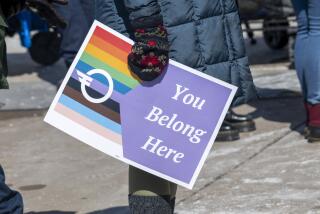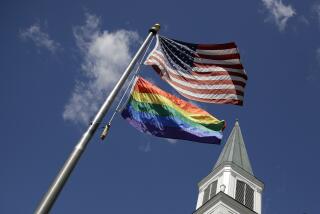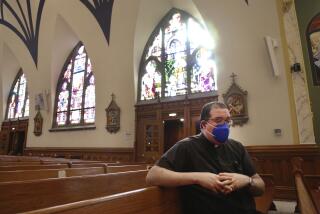55.1% of Americans Linked to Religious Groups, Survey Shows : Membership: Report gives a nationwide breakdown of affiliation by denominations. The West has a large number of non-members.
- Share via
NEW YORK — West of the Rocky Mountains, the American landscape contains large areas where less than one-fourth of the residents are claimed by any Christian or Jewish religious group.
Meanwhile, the nation’s southeastern states and its midsection--stretching from Texas and Louisiana in the South to North Dakota, Minnesota and Wisconsin in the North--are areas of high religious affiliation. Overall, adherents hold a solid majority and spots are rare where adherents are less than 25% of the population.
Facts such as those, contained in a just-released study of American religious activity, are expected to be valuable for church officials--especially when they are pinpointing areas for new churches, said the Rev. William McKinney, a sociologist of religion at Hartford Seminary in Connecticut.
McKinney made his comments here Tuesday at a news conference announcing release of the 456-page study, “Churches and Church Membership in the United States,” which was compiled by the Assn. of Statisticians of American Religious Bodies.
The study shows that virtually the only part of the West with high concentrations of adherents--that is, where more than half of the population is claimed by a religious organization--are Utah and parts of surrounding states, where Mormons are plentiful, and much of New Mexico.
The areas in the West where the unaffiliated outnumber the affiliated by at least 3 to 1 include 14 of Colorado’s 63 counties and large pockets scattered throughout Nevada, California, Oregon, Washington and Montana.
Other areas that fall into that category include scattered sections of Michigan, a crescent-shaped area in central Maine--states where nonbelievers hold a majority over believers--and eastern Kentucky.
Michigan, Ohio, West Virginia, Maryland, Delaware, New Hampshire, Vermont and Florida all have substantial areas where less than half the population is religiously active.
The study, based on figures from the 1990 U.S. Census and data supplied by religious groups, shows that 137 million Americans, or just 55.1% of the population, are affiliated with a religious group in the Judeo-Christian tradition. The study also gives a nationwide, county-by-county breakdown of religious affiliation by denominations.
Some information is unsurprising. It shows that Roman Catholicism is dominant in the Northeast, Southwest and coastal Southern California; that most of the Southeastern states are dominated by Baptists, while Lutherans are the major denominational group in the North-Central states.
Two other denominations--the United Methodist Church and the Christian Church (Disciples of Christ)--are cited as being the dominant groups in scattered counties, primarily in the Midwest.
Mainline Protestant churches that have suffered membership losses and are looking for fertile ground for new churches should pay careful attention to the report, McKinney said. “It would be foolish if you were a United Methodist district superintendent and didn’t have this,” he said.
McKinney, co-author of the 1987 book “American Mainline Religion: Its Changing Shape and Future,” acknowledged that the survey has problems but called it “the closest thing we have to a census of American religious church groupings.”
Beyond the figures available from the study, McKinney said, there are likely to be numerous analyses of the data by sociologists and statisticians.
McKinney said a colleague at Hartford Seminary has culled the study for data on church growth, comparing 10 denominations affiliated with the National Council of Churches to 56 Protestant denominations that are not aligned with the council.
That analysis, he said, showed that nine of the 10 National Council denominations--which tend to be moderate or liberal--experienced an overall membership drop of 6.1% in the 1980s. That decline was a continuation of a trend that began in the mid-1960s. Meanwhile, 40 of the 56 more conservative denominations grew during the same period, by an average of 13%.
One problem area highlighted in the study relates to how denominations collect their data. Some collect data only on full, confirmed members, while others compile data on all adherents: regular participants and children of members who may be omitted from membership counts.
As a result, in some cases the study, which reports on adherents, gives numbers that are higher than denominations report.
For example, the study lists 18.9 million Southern Baptists, compared to 15.2 million reported by the denomination; 3.6 million adherents of the Presbyterian Church (U.S.A.), compared to 2.8 million, and 11.1 million in the United Methodist Church, compared to 8.9 million.
Among some other large religious groups, the numbers are closer to those which the denominations report: Roman Catholicism, 53.4 million adherents; Evangelical Lutheran Church in America, 5.2 million; Church of Jesus Christ of Latter-day Saints (Mormon), 3.5 million.
Another major difficulty concerns data collection for the black Baptist churches. With little statistical information available from the denominations, estimates of black Baptist adherents were based on extrapolations from extensive polls conducted in Georgia, Tennessee and Oregon.
Dale E. Jones of the Church of the Nazarene, one of the five primary survey compilers, admitted that such a process is “risky business,” but said an estimated figure of 8.7 million for black Baptists is better than having no figure at all. “We certainly hope to do better next time.”
The statisticians group had done surveys in 1971 and 1982, but neither of those had figures for the black Baptists.
The study was funded by the Lilly Endowment Inc. of Indianapolis, 17 of the participating denominations, and the Glenmary Research Center, a Catholic institution in Atlanta.
More to Read
Sign up for Essential California
The most important California stories and recommendations in your inbox every morning.
You may occasionally receive promotional content from the Los Angeles Times.













